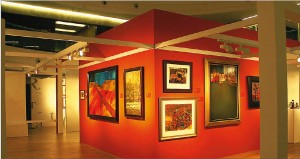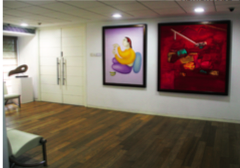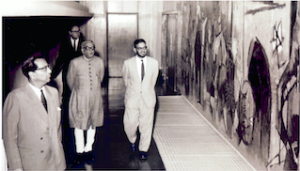Press
Jindal: Corporate and institutional art collections | Mumbai Mirror

 By Mortimer Chatterjee Published in Mumbai Mirror | 7 December 2015
By Mortimer Chatterjee Published in Mumbai Mirror | 7 December 2015
Sangita Jindal is determined to use her position in society for good. Each day is carved into thin precise slices, each slice devoted to one of the myriad projects that she supports.
Arts and culture has always figured prominently in her outlook, and her most recent project may well be one of her most ambitious. A significant number of works from her personal art collection have now found a permanent home at the new headquarters of the JSW Group located in Bandra Kurla. In the execution of this process she has set the standard in the region for the display of art in corporate settings.
She was first exposed to art growing up in Kolkata where her mother, Urmilla Kanoria, was an active patron of the arts (and was also responsible for the Kanoria Arts Centre in Ahmedabad). Early in her art journey Sangita had the chance to work with the legendary arts administrator Jamshed Bhabha, at the National Centre for Performing Arts (NCPA). Out of this interaction was born the Jindal Arts Creative Interaction Centre (JACIC) in 1994. It was later established as the cultural arm of JSW Foundation, known in those days as the Jindal South West Foundation. JSW Steel is one of India’s leading private sector steel producers. It is spread over six locations in India and has a footprint that extends to the US, South America and Africa. As honorary director of JACIC, Sangita’s aim was to promote interdisciplinary arts activity with a view to support and develop appreciation of art and culture.
The next major initiative was the launch of the publication Art India in 1996. Having worked with Anupa Mehta at JACIC, Sangita invited her to become the first editor of the magazine. Over the intervening 19 years, Art India has borne witness to the changing landscape of Indian contemporary art and has been crucially important in providing a voice to art critics operating in the region. Whilst her commitment to the magazine continues unabated, Sangita is aware of the changing nature of the media and sees an inevitable switch Art India will have to make from print to the online space.
Collecting began early; some of her first purchases were works by Anjolie Ela Menon and M F Husain. As her exposure to art grew the collection began to reflect her maturing taste. When asked how she selects works, Sangita remarks, “It is mostly my personal choice. I buy art based on my instinct, how a work of art speaks to me. Most importantly, a work of art should allow me to get in touch with my inner self. If I connect with the artist, it’s great — I like them involved.”
The grand architectural statement that is the new JSW Centre (built by renowned architects Burt Hill, now Stantec) has allowed Sangita free reign over a huge space, much of which is conceived as open plan in form. To encounter an Anish Kapoor installation upon entering the building is an exercise in shock and awe. Other major statement pieces that have been installed onsite include Shilpa Gupta’s constellation of steel books, Rana Begum’s meditative installation and a massive mural canvas by Dhruvi Acharya, that occupies the entire back wall of the company’s all day dining restaurant.
Spanning an incredible 32 feet, the canvas, entitled JSW, features scenes from the typical workdays of employees across the company. These vignettes are woven together by a complex pattern of detailed drawings that portray every conceivable aspect of the JSW world — from factories, to trucks, to the component parts made from the company’s steel. Acharya’s JSW is a tour de force and must rank as one of the artist’s most significant works to date.
The floors occupied by senior management include paintings by significant artists, both modern and contemporary, including M F Husain, S H Raza, Laxman Shrestha, Atul Dodiya and Jagannath Panda. Preeti Sanghi, an architect by training, undertook much of the coordination for this herculean project. Preeti’s indefatigable spirit proved crucial in maintaining deadlines and budgets in the face of challenging circumstances. The results have been gratifying.
When asked what next for JSW’s relationship with art, Sangita dashes off an impressive list that includes architectural projects in Vijaynagar, near Hampi (which also houses Kaladham, an arts complex), as well as the start of classes for drawing and painting at SNDT Kanyashala, now named The Jindal Centre for the Arts in Mumbai. The Jindal art collection is, in this sense, one node in a much larger network. In the absence of state and union level engagement with the arts, it is patrons such as Sangita who are being called upon more than ever to plug the gaps in the cultural life of the country.
Associated Capsules Group: Corporate and institutional art collections | Mumbai Mirror

 By Mortimer Chatterjee Published in Mumbai Mirror | 30 November 2015
By Mortimer Chatterjee Published in Mumbai Mirror | 30 November 2015
Before commercial galleries began to flourish in the early 2000s, art collectors needed to be more self-reliant than is the case today. Searching out artists and their work necessitated a dogged persistence that the present generation of collector may not recognise (bombarded, as they are, by galleries reaching out through digital marketing). In the years when the modern Indian art era gave way to the contemporary, one of the most formidable corporate art collections to have been assembled was undoubtedly that of the Associated Capsules Group (ACG) Worldwide and the Singh family.
Associated Capsules Group is one of the largest manufacturers of empty hard gelatin capsules in the world. It is today an integrated partner to the pharmaceutical industry. The founders of the company, Ajit and Jasjit Singh, along with Jasjit’s wife, the famed interior designer Kavita Singh, are responsible for building a collection that now numbers over 400 individual paintings and sculptures.
Growing up between England and Europe, the brothers had developed an appreciation for Western art and, upon their return to India in the mid-1960s, they quickly began acquiring work by Indian artists in depth. Ajit believes that artists at that time “worked with a passion, though were never fairly compensated.”
An artist whose work was acquired early was M F Husain and Ajit remembers that his paintings were “stacked on the floor in the Gita Art Gallery, at the Oberoi, New Delhi. I used to acquire them just with money left over in my pocket.” Soon many other names would be added, many of whom became the trailblazers of the decades between the 1960s and 1990s — Rameshwar Broota, Jehangir Sabavala, Ram Kumar, Krishen Khanna, Anjolie Ela Menon, Bikash Battarcharjee, S H Raza, N S Bendre, Shiavax Chavda, Arpana Caur, B Prabha, Murli Lahoti, Jatin Das and Shanti Dave.
It was not long before artworks were being hung both in ACG offices and, also, the new factories that were being built across Maharashtra. Given that Kavita Singh’s flourishing interior design firm was responsible for fitting out these spaces, the focus on high quality art was almost inevitable. At this time Kavita was gaining a reputation as a tastemaker in the city, and her signature style was, and still is, evident in many Mumbai best homes. In addition managers of offices were allowed to loan works and display them at home.
This continued until the rise in the value of individual works meant that it was safer to make reproductions for sending to managers’ homes.
During the early years of the ACG art collection, it was still fairly unusual for Indian corporates to acquire aggressively and so there was a fair bit of media attention. Ajit deftly used this platform to put forward a compelling argument for corporate collecting.
He made it clear that he and Jasjit were never concerned as to who the painter was that they were buying, rather it was the work that needed to speak to them, “We have collected many paintings which depict a management principle or capture and freeze a thought or reason for success or failure in a commercial endeavor. In such cases, the appeal of the painting for us was in the message that the painter had unwittingly put onto canvas.”
This was an entirely new way of thinking about paintings, and created a synergy between the art acquired and the context in which it was displayed. As an example he points is the magisterial canvas painting of card players by Krishen Khanna. Here huddled figures are immersed in a game, swaddled in a conspiratorial cloak of dark green. These inscrutable characters are open to a whole host of interpretations.
However, the story that Ajit weaves is one about fate and luck and the element of chance that is as much a feature of life as it is of business. Positioned above the table in his well-appointed office, Ajit’s inner sanctum, the painting functions at the level of decoration, of instruction and, not least, of a heightened aesthetic sense.
Acquisitions continue by both the brothers and there are plans afoot for a major publication on the collection. Today a large range of art advisors exists in India, but what make the ACG collection special is that the family is so involved in every aspect of acquisition and display. It is their engagement with city’s art scene over such a long span of time that marks theirs as one of the truly great corporate art collections of Mumbai.
Piramal: Corporate and institutional art collections | Mumbai Mirror

By Mortimer Chatterje e Published by Mumbai Mirror | 23 November 2015
e Published by Mumbai Mirror | 23 November 2015
The city’s lack of adequate institutional spaces to exhibit art is well known. Even Mumbai’s premier institution, the National Gallery of Modern Art (NGMA), was never built as a museum but, rather, as an auditorium. It is reason to cheer, therefore, that the city is getting a range of new venues courtesy of the Piramal Art Foundation.
Mr Ajay Piramal began collecting art in 2008, purely as a personal interest, whilst his wife, Dr Swati Piramal, has a longstanding interest in the arts of Persia. In more recent times their daughter, Nandini, and their son-in-law Peter, have developed an interest in contemporary Indian art. The Piramal group is a diversified conglomerate with operations in over 30 countries and a strong presence in more than 100 markets in the world.
Since the late 1980s, it has evolved from a textile-centric business to operating in sectors such as healthcare, life sciences, health care information management, financial services, specialty glass packaging and real estate. Given that the motto of the company is ‘Knowledge, Action, Care’, art acquisition seems a particularly apt endeavor. Over the last seven years, there has been an increasing focus on building a collection that will eventually be housed in public spaces associated with the family’s numerous real estate interests. The first of these venues is ready to open to the public this week at Peninsula Corporate Park in Lower Parel.
This functions as a serious statement of intent and is great news for the city that, up till now, has seen precious few new art initiatives.
The main focus of the art collection is the era of modern Indian art; that is, art produced in India in the years following close on the heels of independence. Of course, the art scene in India in the mid 20th century didn’t appear out of the blue, and so the collection has taken care to acquire work that provides a historical framework: a 300-year historical framework! The Modern art movement in India was loyal to a vigorous synthesis of styles both indigenous and Western. As such they looked to influences as diverse as Mughal and Rajput miniatures, classical sculpture, as well as major figures from 20th century European painting such as Paul Klee, Joan Miro and Pablo Picasso. The art collection of the Piramal Art Foundation is keen to include works that track these influences, especially as they relate to the history of the arts in India.
The spurt of acquisitions in the recent past has been made both at auction and privately, and a handsome publication, brought out recently, details many of the most exciting purchases from the last decade.
There are a range of works representing a diverse range of styles and movements such as Bengal School artists Abanindranath Tagore and Nandalal Bose, through to the high abstraction of V S Gaitonde and, more recently, important works by Manjit Bawa.
The team working on the art collection of the Piramal Art Foundation now includes a full-time researcher and a rapidly expanding library.
Scholars will be encouraged to use the collection as source material and the office in Lower Parel has a workspace that will remain open 24 hours a day. As public displays of the collection begin to be rolled out, it becomes increasingly important to the Piramals, and their advisory team, that coherent stories be told through the artworks acquired.
At a moment when many feel that the existing history of modern Indian art is in serious need of revision, this news is particularly welcome. And it is not always the big headlining histories that are the most interesting. As an example, the team recently discovered that amongst the several views of Benares present in the collection, painted over a span of 200 years or more, the same vistas keep on popping up. To be able to trace the architecture of cities, through the visual record left by artists, is but one of many possible microhistories waiting to be told.
The future of the Piramal Art Foundation, as told by Mr Piramal, sounds promising. “I would like to organise workshops where young artists come and they get the opportunity to develop their art, and then provide them the gallery space where they can get some value out of their art”. He continues, “Art should be in everyone’s lives irrespective of what economic strata you come from. And this we hope to achieve in whatever little way we can, by supporting artists and building collections that the public can enjoy.” This sounds an engaging proposition, and something that has not been seen in India since the opening of the Kiran Nadar Museum of Art (KNMA) in Delhi, in 2010.
As this column continues to trace the histories of great corporate and institutional collections of Mumbai, the Piramal Art Foundation takes its place as a ‘future great’; an exciting addition to an already illustrious group of corporate names that have taken a leap of faith and looked to art patronage in a serious and sustained manner.
Godrej: Corporate and institutional art collections | Mumbai Mirror

 By Mortimer Chatterjee
By Mortimer Chatterjee
Published in Mumbai Mirror | 16 November, 2015
Dr. Pheroza J. Godrej has played an integral role in the city’s art scene for more than forty years. She is internationally acknowledged as both a connoisseur of the arts and an art historian, with a remarkable ability to shift registers between the public and private. At the level of policy and headlining initiatives, she was, until very recently, the Chairperson of the Advisory Board of the National Gallery of Modern Art, Mumbai. She is presently on the Executive Committee of the National Culture Fund, Ministry of Culture; a trustee of the Indira Gandhi National Centre for the Arts, New Delhi; the Honorary Secretary of the Museum Society of Bombay and founder of one of the city’s longest running galleries. As an enthusiastic and serious collector of art, she has built an enviable collection, The Jamshyd & Pheroza Godrej Art Collection. This collection, like others started during the first few decades after India’s Independence, reflects an individual’s taste writ large over an organization.
The initial spurt in acquisitions was due, in large measure, to Dr. Godrej’s establishment of Cymroza Art Gallery, in 1971. This was the main source for many of the paintings that came to form the collection. The philosophy that inspired her was simple; if she believed in an artist enough to select him/her to exhibit at her gallery, then she felt compelled to support this belief by personally acquiring the artist’s work.
The inevitable consequence of continued acquisitions was the loan initiative to Godrej offices around the country. Initially, this dispersal was restricted to contemporary prints (the collection represents one of the strongest in the region). The project met with much success and was subsequently broadened to include oil on canvas and works on paper. Those in charge of branch offices countrywide were encouraged to select artworks from the collection for display at their workspaces. The key factor when selecting works for display was to gauge whether a lay art-enthusiast would relate to a particular work.
Dr. Godrej’s office is located in Godrej Bhavan, in the Fort area of Mumbai (the building’s architecture is itself worthy of note). Her office walls are covered by paintings that hang, salon style, one above another. As she says apologetically, “I have not been very disciplined myself of what I put up, and don’t put up”. However in important public spaces, especially at Godrej Bhavan, Dr. Godrej takes great personal interest in the display of art works, and it is here that some of the masterpieces of the collection reside, including examples by Manjit Bawa, Jehangir Sabavala, and N. S. Bendre – as also a number of fine classical Indian sculptures.
Beyond acquiring art, there has been a long-standing attempt to engage local communities, especially those living and working at Pirojshanagar – the Godrej industrial garden township in Vikhroli. In the late 1970s Haku Shah, the famous Ahmedabad-based artist, was invited to conduct art camps for children attending the Godrej Udayachal School. Along with Dr. Godrej, this project had the support of family members Smita Vijay Crishna and the late Soonu Naval Godrej. Named ‘Creativity and Hands’, it also involved Madhubani artists as mentors. Whilst similar art camps continued, the company also took on an artist-in-residence, Mr. Mangutka from M. S. University, Baroda, and a pupil of the renowned sculptor Sanko Chaudhuri.
In 2015, the artist-in-residence program has been given a new lease of life by a team comprising Jamshyd and Pheroza Godrej’s son, Navroze Godrej, and the Godrej Innovation Centre and Godrej Archives. The first artist to be invited has been a California- based artist, Jeremy Meyer, who exclusively works with typewriters as his medium. Using the parts sourced from the classic and historic Godrej ‘Prima’ typewriter, the artist has created an extraordinary kinetic lotus that unfurls its petals at the beginning of the working day and closes them at the close of the day. An exciting program of events is now being developed for the residency, and this will roll out over the next year.
Dr. Godrej and Navroze have also put in place a coherent plan of conserving and cataloguing the existing art collection; for instance biographies are being compiled on lesser-known artists in the collection. In due course, it is intended that the collection becomes a resource for scholars, particularly those interested in the history of printmaking and pottery in India during the modern and contemporary eras.
The Taj Mahal Palace, Mumbai: Corporate and institutional art collections | Mumbai Mirror
By Mortimer Chatterjee
Published in Mumbai Mirror | 9 November, 2015
Starting at 7.30pm on the 19th December 2013, Christie’s held its first auction in India, at the Taj Mahal Palace, Mumbai. It brought together a group of paintings that, by 11pm, became the most valuable group of paintings to have ever been assembled in the region for the purposes of public sale. After the auction, collectors bubbling with excitement emerged from the banquet hall. Descending the grand staircase, they passed a group of paintings from the collection of the Taj Mahal Palace hotel, put on display especially for the event. On the wall were fine examples by the very same artists who had just achieved dizzying prices at the auction: S.H. Raza, V. S. Gaitonde, Jehangir Sabavala. Here, in the collection of a single hotel, were artworks that could compete in quality with best that an international auction house could assemble. The point being made by the management that evening was clear: theirs is no ordinary hotel art collection. There are few places in the world quite like the hotel, and there are few art collections quite like the one on display there.
The creation of the Taj Art Gallery in the 1950s gave the hotel the ability to acquire first-rate art. The gallery saw a very great many of the most important artists of the era mount exhibitions. In the absence of a large commercial gallery scene, it made sense for artists to rent the space themselves. Of course, the fact that there was an art gallery did not by itself guarantee that the hotel would take the initiative to build a collection. Two women in particular are to be thanked for the acquisitions process: Rodabeh Sawhny (the sister of JRD Tata) and Elizabeth Kerkar (wife of then general manager, Ajit Kerkar). Over a large spread of time, they took responsibility for the furniture and furnishings of the hotel and saw to it that paintings were purchased at a rapid rate. Before long, a particular taste can be seen to have emerged. It tended toward a monochromatic palate with a definite bias for abstract painting.
Highlights in the collection include a number of Ram Kumar works, all abstracts, spanning a substantial part of the artist’s career (the earliest dates from 1965; the last was executed in 1987). There are a number of canvas works by V.S. Gaitonde that hone in on a key period for the artist, between the mid-1960s and the late 1970s. Other major names included in the collection are Jamini Roy, K.H. Ara, Tyeb Mehta, N.S. Bendre, K.K. Hebbar, Vivan Sundaram, Gulam Mohammed Sheikh and B. Prabha.
Two artists who have had extra-close relationships with the hotel are Jehangir Sabavala and Laxman Shreshtha. In the case of Sabavala, there are paintings in the collection that he created whilst living for extended periods at the hotel (the artist’s father was part of the hotel’s management). His sensitive watercolour on paper rendering of the harbour view, as seen from the sea-facing rooms of the hotel, is today one of the most well known paintings in the collection. Laxman Shreshtha has been a friend of the hotel and its management for many decades, and this is evidenced by the significant holdings of his work. One painting, in particular, that deserves highlighting is the collaboration that he undertook with Ratan Tata; a canvas that today hangs in the Heritage Wing of the hotel.
Subsequent to the attack on the Taj, in November 2008, the hotel underwent a large series of renovations to the public areas, the rooms and the suites. As part of these changes, the display of the art collection was completely overhauled in order to give priority to its most important works. A large conservation program saw many paintings undergo thorough treatment. Walkthroughs of the collection, by trained staff, were put in place to highlight the masterpieces. In addition, in a number of public spaces (such as the Habour Bar, the Ballroom and the Heritage Wing Lounge), special care was taken to create a conversation between the artworks on display.
Today the Taj Mahal Palace, Mumbai, art collection is presented in a manner that does justice to the quality of the paintings themselves, and adds character to an already extraordinary environment. Excitingly, plans are afoot to reopen the Taj Art Gallery before the end of 2015. Given the fact that the hotel finds itself located in the heart of the city’s art scene, with galleries clustered around the property, this initiative seems well placed to recapture the hotel’s position as a pre-eminent venue for buying art.
TIFR: Corporate and institutional art collections | Mumbai Mirror

 By Mortimer Chatterjee
By Mortimer Chatterjee
Published in Mumbai Mirror | 2 November, 2015
Any discussion of great institutional art collections whether in India or, indeed, globally, has to contend with the group of modern Indian paintings and sculptures housed at the Tata Institute of Fundamental Research (TIFR), based in South Mumbai.
It was the first director of the TIFR, Homi Bhabha, who initiated the idea of the collection in 1952, at about the same time that Nehru apportioned a large swathe of land for the building of a new campus for the Institute. From the outset, Bhabha was committed to housing his scientists in an environment that was highly sensitized to beauty, informed by an India newly emboldened through self-rule. The art took its place in a great modernist building set in elaborately landscaped gardens.
In order to build the TIFR holdings in the style of a great museum collection, the first director made the inspired decision to engage a group of advisors. These were all art world insiders, including the influential art critic Rudi Von Leyden. Add to this the fact that 1% of the yearly budget was apportioned to the acquisition of art, almost certainly a first in India.
The outcome of this meticulous planning was the creation of an art collection without peer. The collection is relatively small, less than three hundred paintings and sculptures, and yet the number of master works is remarkably high. It is worth remembering that Bhabha, and his advisors, were buying work from artists who, in the main, had no track record to speak of. Interesting new research released by the TIFR archives, headed by Oindrila Raychaudhuri, has shed light on how acquisitions were concentrated into a tight time period. Between 1961 and 1968 more than a dozen works were purchased per annum.
Highlights from the collection include a magnificent group of works by V.S. Gaitonde, that trace the artist’s career from the mid-1950s, right up till the 1970s. There are also large holdings of major names from the period, including K. H. Ara, Tyeb Mehta and M.F. Husain. Indeed, the Institute is custodian to one of the greatest of all Husain’s works, an awe-inspiring canvas that stretches the full length of a wall and greets visitors entering the main building of the campus. This work, executed during 1962 and 1963, came about as the result of a competition that invited young, mid-career and senior artists of the period submit to-scale proposals.
The mural competition included entrants such as Satish Gujral, N. S. Bendre and K. K. Hebbar who, at that time, were amongst the younger entrants. The most senior artist in the group was the great Bengali painter, Jamini Roy, and letters between him and Bhabha show that the Director of TIFR was keen to make it clear that any submission from Roy would be considered a finished work, and prized by the institute as such. This brilliant piece of diplomacy resulted in the old master from Calcutta making a work that must count as one of the largest single paintings ever executed by him. If making artists compete with each other was rare enough, Bhabha had even toyed with the idea of inviting the greatest living artist of that era, Pablo Picasso, to come to India and undertake the project. The plan came to nothing as the Sino Indian war had erupted in the meantime, causing difficulties with the logistics of foreign exchange.
Perhaps most exciting to the student of modern Indian art are the new insights that the TIFR art collection affords. In particular, the concentration of artists about whom little is written about today. An example of this is Homi Patel, an artist virtually absent from present scholarship, yet one who is strongly represented in the TIFR art collection.
Bhabha died prematurely in 1966, in an airplane crash in the Swiss Alps. This tragedy could well have seen interest in the art collection tapering off. Thankfully, the second director of the institute, M.G.K. Menon, was committed not only to maintain but, also, add significantly to the holdings.
After a lengthy period when the collection remained fairly remote from public consciousness, focus once more returned five years ago with a large-scale conservation program, the publication of a book on the collection and a major exhibition mounted at the National Gallery of Modern Art, Mumbai. Recently the TIFR became a new member of the Google Cultural Institute. With examples from the collection now also featuring in major international exhibitions, it is clear that the Institute is once again playing a full part in the global cultural discourse of our times. Bhabha would most certainly approve.


